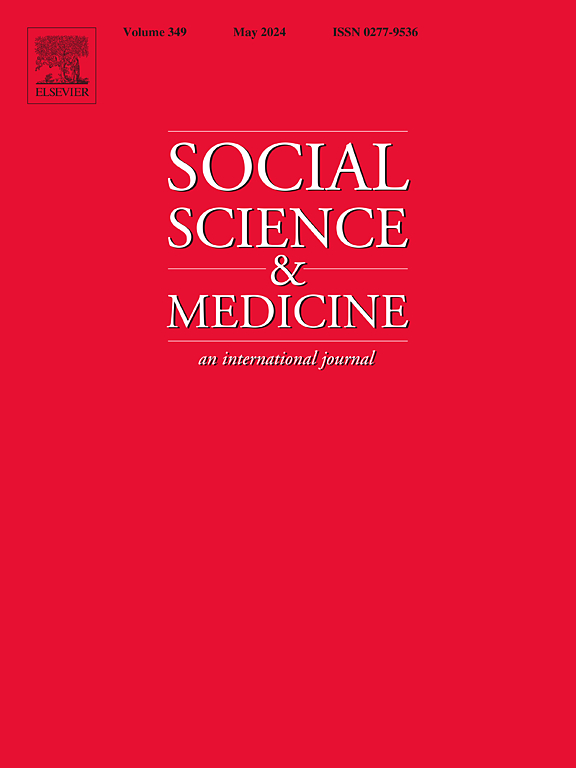引人深思:SNAP 耻辱感、粮食不安全和性别之间的交叉。
IF 4.9
2区 医学
Q1 PUBLIC, ENVIRONMENTAL & OCCUPATIONAL HEALTH
引用次数: 0
摘要
补充营养援助计划(SNAP)每年帮助数百万低收入家庭负担和购买食品。先前的研究指出,福利污名化--对参与公共援助计划的人的负面成见--会限制 SNAP 的参与。成见还可能导致男性参与者等亚群体的心理健康状况恶化;定性证据表明,由于性别角色的规范,男性可能难以接受公共援助福利。然而,关于哪些人最有可能遭受污名化、污名化与粮食不安全的关系、这种关系是否因性别认同而异以及污名化是否与网上购物(可防止污名化)有关等问题的研究却很少。为了弥补这些不足,我们分析了一项针对 1383 名 SNAP 参与者的全国性调查,了解他们在 SNAP 耻辱感、粮食不安全和网上购物方面的经历。在调整模型中,我们发现与女性参与者相比,男性参与者报告任何污名化经历的几率要高出 40%(95% CI:1.09-1.80)。与未报告成见的参与者相比,报告成见的 SNAP 参与者的粮食不安全几率是后者的三倍多(OR:3.54,95% CI:2.60-4.81),报告成见的男性参与者的粮食不安全几率是报告成见的女性参与者的近三倍(OR:2.94,95% CI:1.53-5.66)。此外,成见与在线购物或在线使用 SNAP 福利并无明显关联。在这一全国性的 SNAP 参与者样本中,男性受访者遭受福利污名化的几率更大,遭受污名化的经历与粮食不安全的几率更大,与女性受访者相比,遭受污名化的男性受访者粮食不安全的几率更大,污名化与网上购物行为无关。可能需要努力重新构建公共援助,以消除 SNAP 等计划的污名化,从而提高非参与者对计划的接受度,并改善参与者的健康状况。本文章由计算机程序翻译,如有差异,请以英文原文为准。
Food for thought: The intersection between SNAP stigma, food insecurity, and gender
The Supplemental Nutrition Assistance Program (SNAP) helps millions of families with low incomes to afford and purchase food each year. Prior research has noted that welfare stigma—negative stereotypes about people who participate in public assistance programs—can limit SNAP participation. Stigma may also contribute to worse mental health among subgroups like male participants; qualitative evidence suggests males may struggle to accept public assistance benefits due to norms surrounding gender roles. Yet there is little research about who is most likely to experience stigma, how stigma relates to food insecurity, whether this relationship varies by gender identity, and whether stigma is associated with online shopping (which may protect against stigma). To address these gaps, we analyzed a national survey of 1383 SNAP participants about their experiences of SNAP stigma, food insecurity, and online shopping. In adjusted models, we found that male participants had 40% higher odds (95% CI: 1.09–1.80) of reporting any stigma experience compared to female participants. SNAP participants reporting stigma had over three times the odds (OR: 3.54, 95% CI: 2.60–4.81) of reporting food insecurity relative to those not reporting stigma, and male participants reporting stigma had nearly three times higher odds of food insecurity than female participants reporting stigma (OR: 2.94, 95% CI: 1.53, 5.66). In addition, stigma was not significantly associated with shopping online or using SNAP benefits online. In this national sample of SNAP participants, male respondents had greater odds of welfare stigma, experiences of stigma were associated with greater odds of food insecurity, male respondents experiencing stigma had greater odds of food insecurity compared to female respondents, and stigma was not associated with online shopping behaviors. Efforts to reframe public assistance may be needed to destigmatize programs like SNAP to both improve program uptake among non-participants and improve health outcomes among participants.
求助全文
通过发布文献求助,成功后即可免费获取论文全文。
去求助
来源期刊

Social Science & Medicine
PUBLIC, ENVIRONMENTAL & OCCUPATIONAL HEALTH-
CiteScore
9.10
自引率
5.60%
发文量
762
审稿时长
38 days
期刊介绍:
Social Science & Medicine provides an international and interdisciplinary forum for the dissemination of social science research on health. We publish original research articles (both empirical and theoretical), reviews, position papers and commentaries on health issues, to inform current research, policy and practice in all areas of common interest to social scientists, health practitioners, and policy makers. The journal publishes material relevant to any aspect of health from a wide range of social science disciplines (anthropology, economics, epidemiology, geography, policy, psychology, and sociology), and material relevant to the social sciences from any of the professions concerned with physical and mental health, health care, clinical practice, and health policy and organization. We encourage material which is of general interest to an international readership.
 求助内容:
求助内容: 应助结果提醒方式:
应助结果提醒方式:


